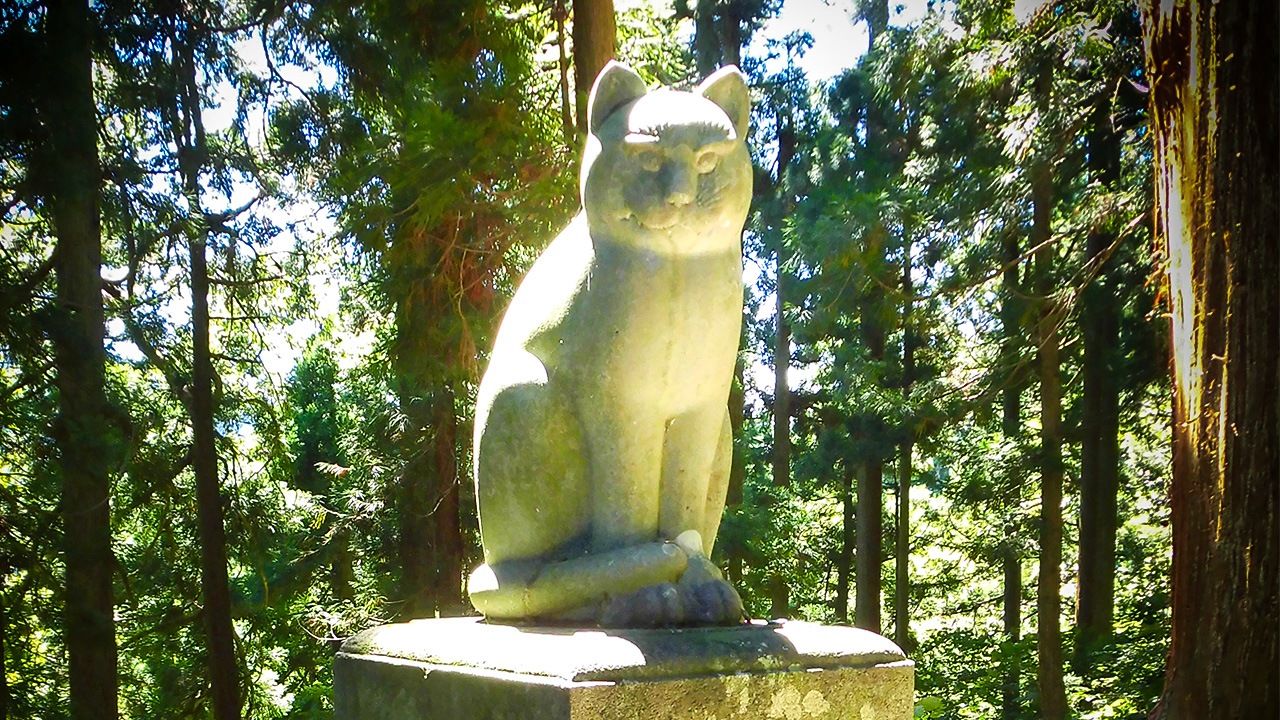
“Waneko” Studies: A Journey into Japan’s Cat Lore
Culture Society History Lifestyle- English
- 日本語
- 简体字
- 繁體字
- Français
- Español
- العربية
- Русский
The Imperial History of the Waneko
Iwazaki Eiji has literally lived his whole life with cats, which his family was keeping as pets since before he was born. He went on to study feline nutrition at university, but began researching the history of the animals’ domestication out of purely personal interest. The prevailing theory when he began was that cats were first domesticated in ancient Egypt around 4,000 years ago, when they were considered sacred. “And then, in 2004, the 9,500-year-old bones of a young cat were found on the island of Cyprus,” says Iwazaki. “The creature was buried along with a human in a grave at the Shillourokambos ruins, so now we believe that housecat domestication dates back long before the time of ancient Egypt.”
Turning to his own country, Iwazaki goes on: “The ancestors of Japan’s common housecat, or ieneko, were once thought to have come via the silk road some time during the Nara period [710-794] or early Heian period [794–1185]. They were brought on ships to protect Buddhist scrolls from rats. In 2011, though, the Yayoi period [300 BCE–300 CE] Karakami ruins on Iki island, Nagasaki Prefecture offered up bones that were identified as belonging to a domestic cat, Japan’s oldest. It appears cats were kept as pets there 2,000 years ago. I believe the features that have developed since then, like the turtle shell patterns or bobtails, could indicate some genetic differences from western cats, and I’d like to study that and see if the waneko can be established as a distinct breed.”
Housecats as pets were still a rarity in the Heian period, and were mostly the treasured pets of the emperor and nobility. “The Japanese imperial family has the longest unbroken royal history in the world, and also the longest history with cats,” explains Iwazaki. “The emperors themselves have a particularly deep connection. The diaries of Emperor Uda [r. 887–931] are part of the public record, and include detailed entries on cats. He talks about receiving a black cat at age seventeen from his father, Emperor Kōkō, and his writing seems to reveal a deep affection for it. Emperor Ichijō [r. 980–1011] was also known for his love of cats, and the Pillow Book written by Sei Shōnagon describes how he doted on his pet, even giving it a special court rank.”
His research into cat history did not turn up many other mentions in the official records, but when he turned to folklore the depth of information drew him in.
Cat Legends Abound
“When I actually looked into the old documents, I was surprised at how many places with cat legends there were. The internet is full of fragmented information and misunderstandings, though. I decided I wanted to leave an accurate record for future generations, and that’s why I started my tour.”
Iwazaki began visiting historical sites with connections to cats soon after he got his doctorate. He spent a week touring cat-lore-related shrines and temples that he found on the internet or in guidebooks. Since then, he has visited 100 such sites all over Japan.
Iwazaki is happy to discuss details he has uncovered. “Niigata Prefecture in particular, which has the most shrines in Japan, has a lot of cat folklore. It’s Japan’s biggest rice grower, so the danger of rats might have something to do with that. For example, the shrine Nanbu Jinja in Nagaoka is also known as Nekomata Gongen, with the neko in the name referring to the animal. A stone statue of a cat welcomes visitors, and when silk farming was more common people came here to pray for protection of their silkworms and rice crops from rats.” There is similar folklore all over Japan, but some areas have a much greater concentration.
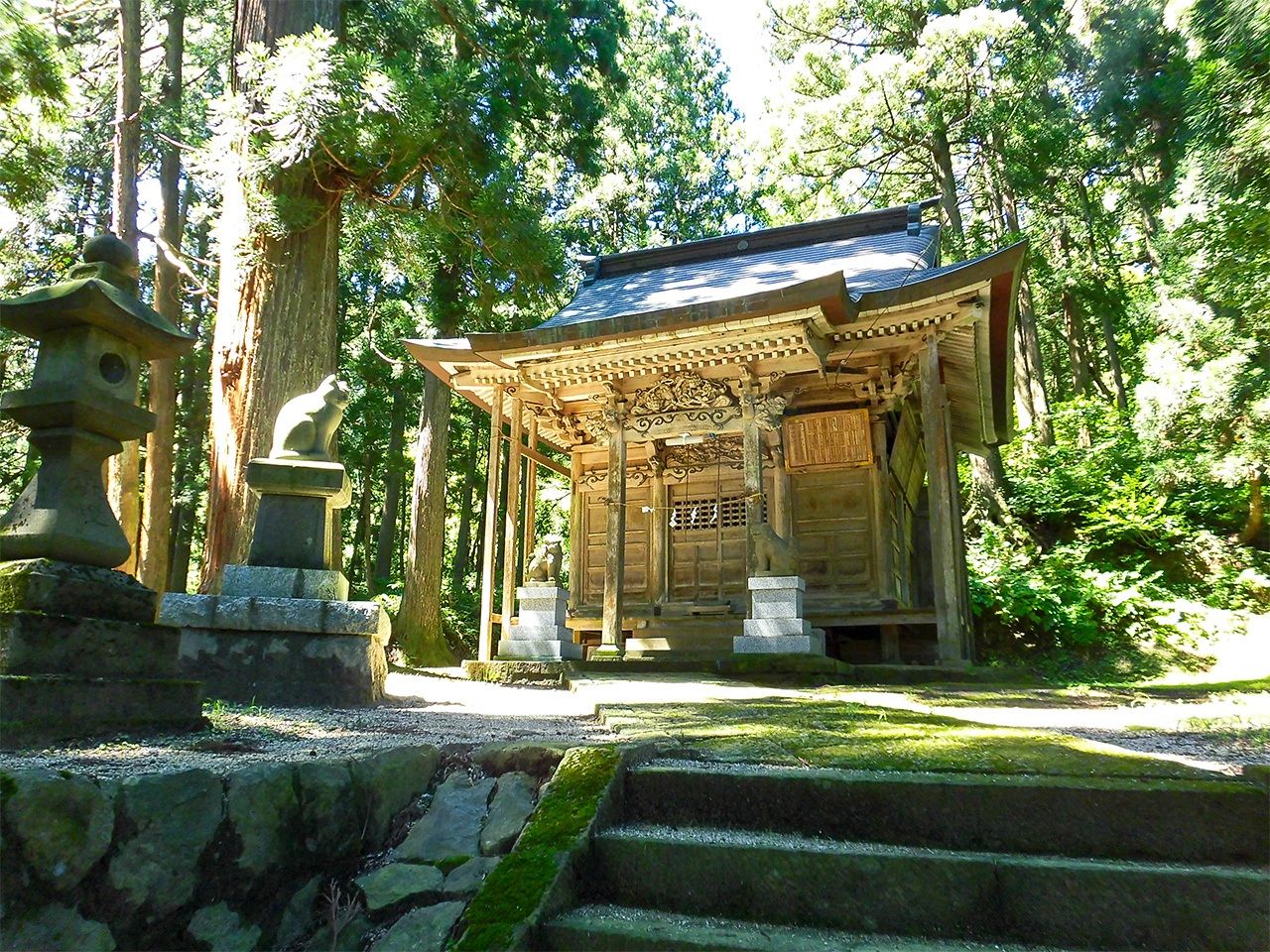
Nanbu Jinja in Nagaoka, Niigata Prefecture.
“One of the most common legends in the Tōhoku region is that of neko danka, or the temple cat. The story goes like this: Once upon a time, a monk at a very poor temple had a cat. One day, the cat vanished. Then, it came to the monk in a dream and said, ‘Not far away, there is a funeral at a rich man’s house. I am going to cause some trouble there. Speak this incantation, and I will stop. When you do, the rich man’s family will pay you handsomely, and the temple will prosper.’ And, just as the cat promised, the monk’s spiritual powers become famous, and the temple prospered.”
Cats helping humans are a common theme in these tales, explains Iwazaki. “Nagano Prefecture has an abundance of legends connect to karaneko, or Chinese cats. The ones that remain in the area around the Karaneko Jinja shrine are particularly famous. The legend goes that someone borrowed a neighbor’s karaneko to get rid of a monstrous rat. The cat was large enough to fight the giant rat to the death.”
Legends of Old Yasaburō and the Nekomata
One of Niigata’s most famous yōkai is Yasaburō-bā, or Old Woman Yasaburō, a human-eating demon that took the form of an old woman. “In the Tōhoku region, people long ago would try to scare their children into behaving with stories of the yuki onna, or ‘snow woman,’ coming to take away children who make noise at night, but in Niigata the threats were about Yasaburō-bā instead.” The legends say that Yasaburō-bā was the mother of a master blacksmith who worked at Yahiko Shrine in northern Niigata, but when her son lost a competition with a carpenter, her rage turned her into a demon.
Another legend ties this monstrous demon to the goddess Myōtara-ten, who is venerated at the nearby temple Hōkōin. The story is that there was once an old woman on Sado Island who loved cats. One day, when she was rolling around in the sand playing with a cat, she turned into a bakeneko, or monster cat, and flew off toward Mount Yahiko. When she got there, she brought devastation on the villagers who tried to kill her. In the end, people began worshipping the old woman as Myōtara-ten because the character for cat can be pronounced myō, as well. Iwazaki notes, “This is not an official tradition, though, and Myōtara-ten worship at Hōkōin temple has no connection with cats.”
There are some legends that are even backed up by official records. “In the village of Nakanomata in Niigata Prefecture, there is a famous story about a strong villager, Ushiki Kichijūrō, who was able to defeat a feline yōkai called nekomata. An official document from 1683 actually describes the extermination, with a measurement of the carcass putting it at the size of a calf, and the sword Ushiki used was kept in a local museum.
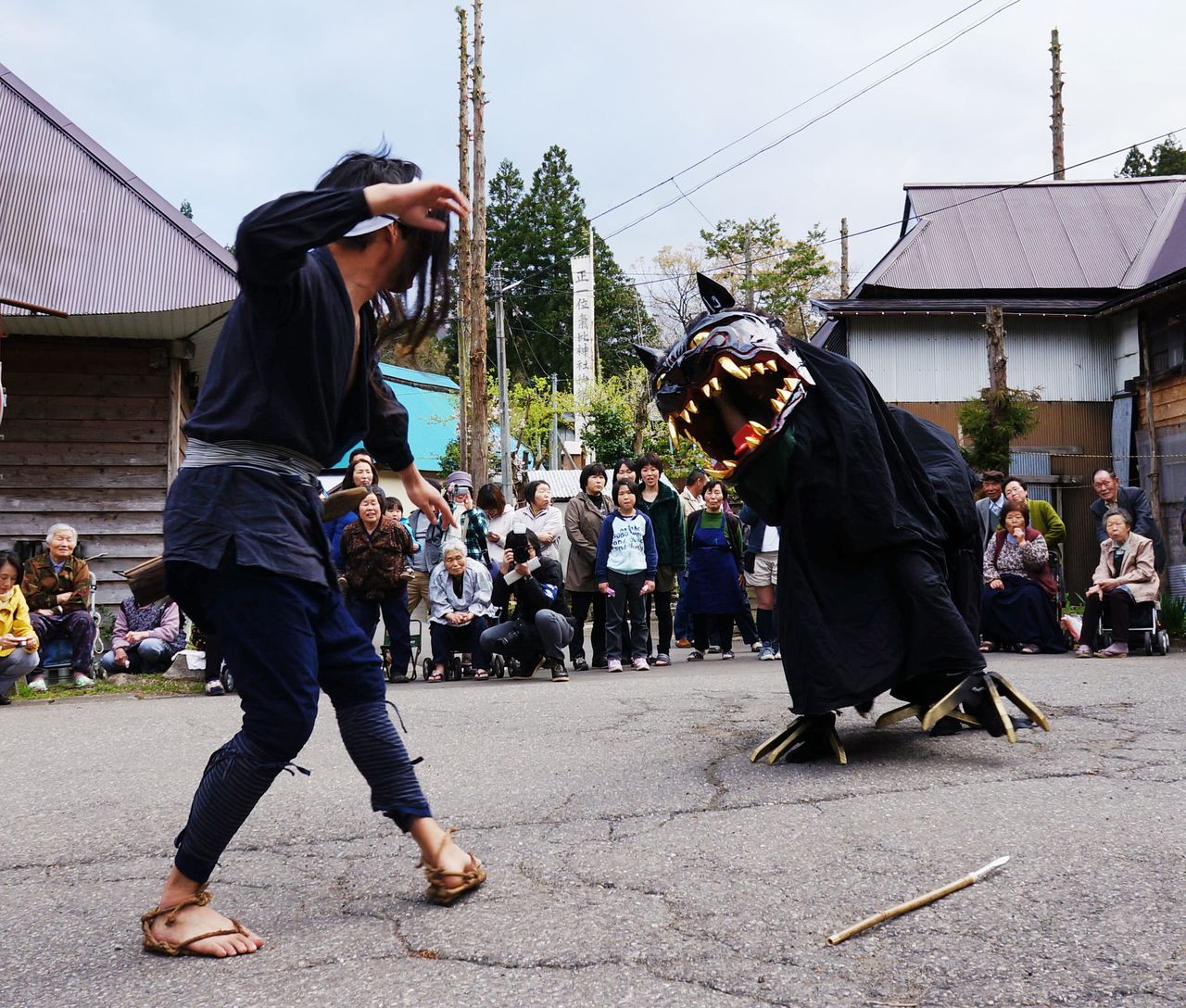
The May 2012 Nakanomata village spring festival featured a reenactment of the defeat of the nekomata, and it has been held several times since then. (© Kamiechigo Yamazato Fan Club)
Iwazaki says that this story might also be connected to a nekomata legend told in the region around Mount Fuji. “There is a legend connected to Mount Nekomata in Toyama Prefecture’s Kurobe gorge. Fuji Gongen, a manifestation of the Buddha as a Shintō kami, became angry at a nekomata and drove it from Mount Fuji, so it came to live on Mount Nekomata. It began causing trouble, even eating the local people. The story goes that a group of hunters surrounded the cat’s lair on the mountain and tried to exterminate it, but it somehow evaded them. It could be that this nekomata escaped to Niigata and began eating people in Nakanomata until Ushiki defeated it. The deeper I dug, the more connections I found between the stories told in each region. The research still isn’t finished, but I love the thrill of unraveling real mysteries.”
The Bakeneko and Manekineko of Edo
Cat legends seem to be split between those that help and repay favors to their owners like the neko danka, and monsters like nekomata that attack people. The idea of monstrous cats was particularly popular in the Edo Period (1603–1868). “There are things we can infer from nutritional evidence,” surmises Iwazaki. “Cats require daily caloric intake equal to about ten mice. They need a lot of protein, and are quick to hunger. If they get hungry enough, they’ll eat any kind of meat. In the premodern era, people may have been frightened after witnessing starving cats eating human corpses, and that may have been the root of monster cat legends.”
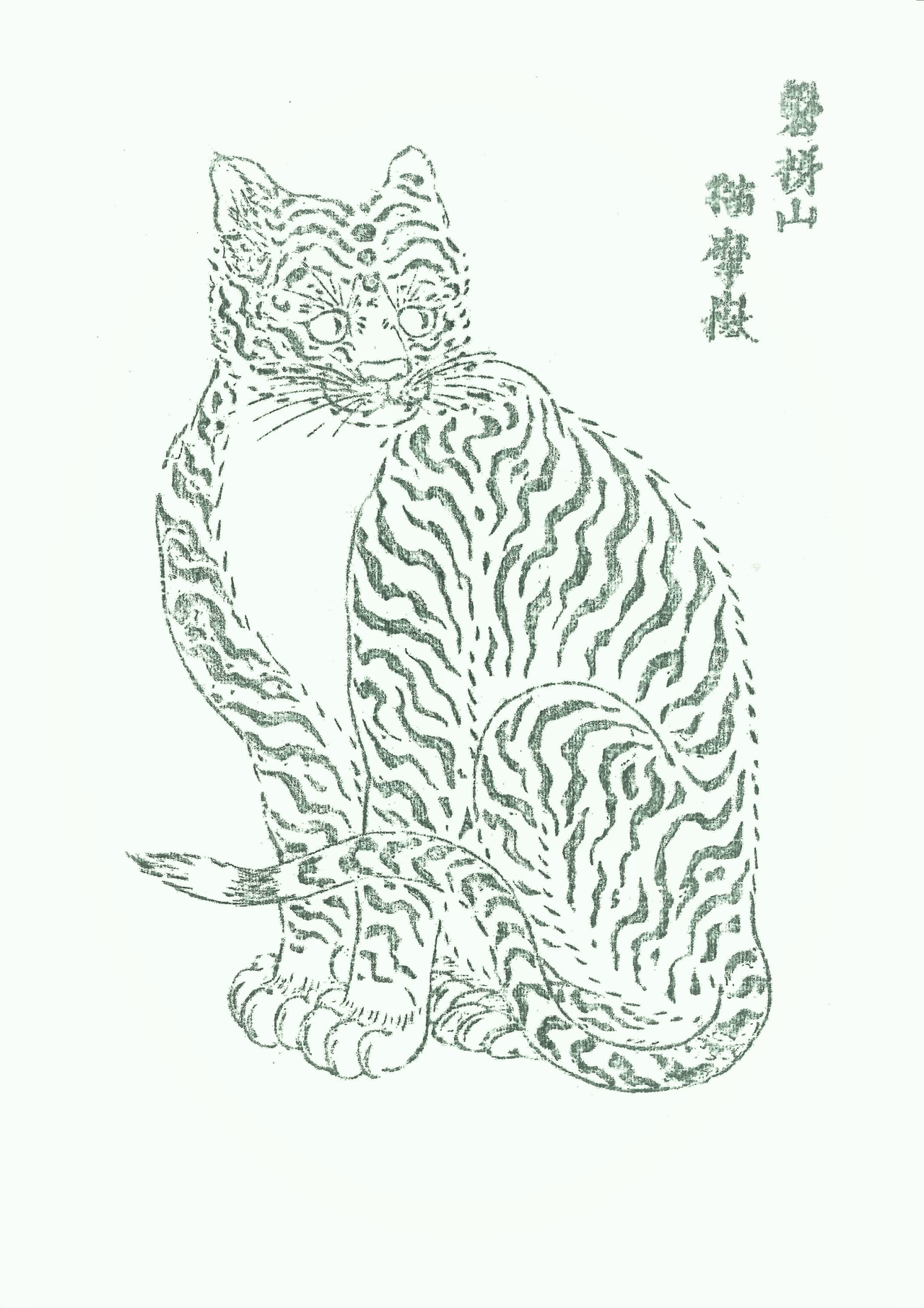
A cat charm distributed by Bandai Shrine in Fukushima Prefecture during the heyday of silk farming.
There are other ways the legends of demonic cats might have arisen. Since cats are natural carnivores, they are not particularly fond of carbohydrates like rice, a traditional mainstay in the days when eating meat was frowned upon for religious reasons. “In the Edo period, people used fish oil in lanterns, and the sight of cats standing on their back legs in the dark licking the oil off of lanterns likely caused some fear, as well.”
There was also a time during the Edo period when cats became extremely valuable. “In regions with booming silk farms, cats were traded as valuable tools to keep silkworms safe from rats. There are records showing a horse being worth one ryō, a standard gold coin, while cats sometimes went for five.”
Manekineko (beckoning or lucky cat) figurines with paws raised to invite people in and to bring prosperity to business first became popular during the Edo period as well, but there is no one definite explanation of their origin.

The book’s cover is a picture of the manekineko at Gōtokuji.
Gōtokuji, a temple in Tokyo’s Setagaya, is well known for its connection to the manekineko tradition. It was once an impoverished temple known as Kōtoku-in. Then, long ago, the head monk’s cat beckoned to Ii Naotaka, an important daimyō of the Tokugawa shogunate, drawing him and his hawking party into the temple. Soon after, a violent thunderstorm struck. Ii was delighted at having avoided the disaster, and also inspired by the monk’s sermon on the Dharma. He adopted the temple for his family, and it prospered under Ii patronage. Today the temple has a hall called Shōfukuden where worshippers dedicate smiling manekineko figurines, which can be viewed there in great numbers.
Imado Shrine in Taitō, Tokyo, is a popular shrine for marriage blessings, and is also known as a manekineko shrine, with a handful of large ones standing in front of the main hall. While this shrine is not the origin of the figures, it is the home of the local specialty Imado ware. Imado marushime-neko figurines, which became popular at the end of the Edo period, are considered to be a kind of prototype manekineko.
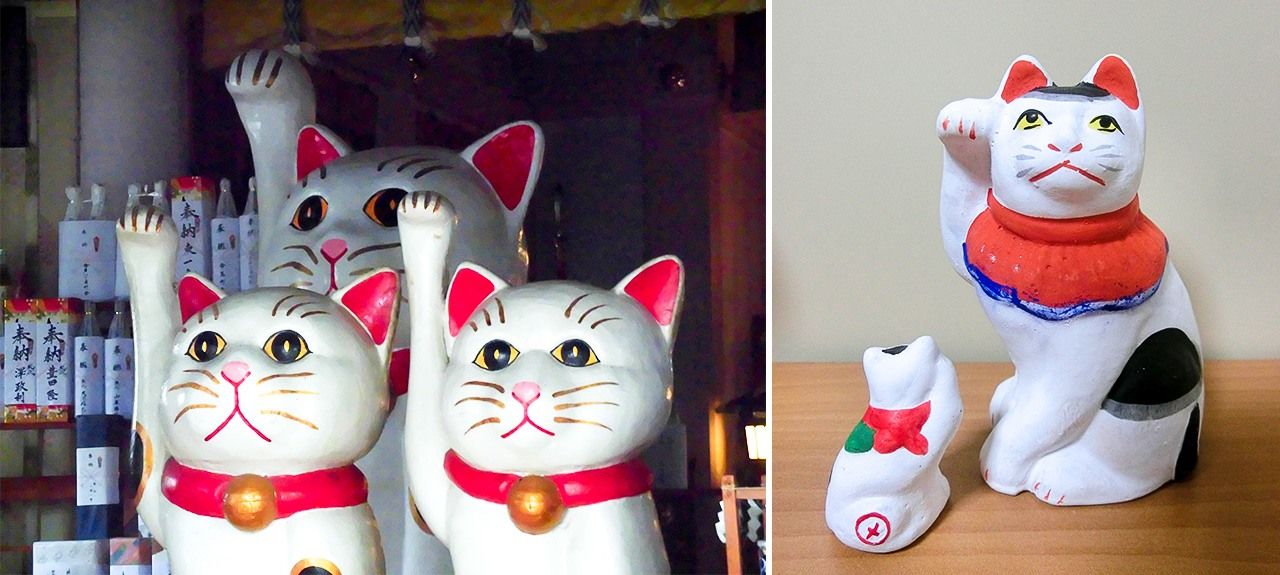
The giant manekineko of Imado Shrine, at left, and a marushimeneko (right).
There is one theory that says manekineko originated from Usugumo Dayū, an oiran courtesan of old Yoshiwara, whose beloved cat protected her from a giant snake. “There is a strong connection between prostitutes and cats, with several stories about cats enchanted by beautiful women and how they showed their loyalty,” Iwazaki says.
Why do so many manekineko wear red collars? Iwazaki explains. “There is a passage in the Pillow Book that describes a cat with a white tag on the red leash trailing behind it as something charming. And the Edo period portraits of beautiful women often featured a black and white cat wearing a red collar, based on the story of the Third Princess from the Tale of Genji. Those are the roots of the red collars still seen on the figures.”
Vanishing Traditions
Those neck attachments were also used to keep the cats from running off. “In the Heian period, cats were precious creatures that only the nobility could keep, and so they were often leashed to keep them from escaping. The practice of keeping cats tied was maintained by cat lovers into the Edo period.” It stayed firm until around the sixteenth century. That is implied by the 1602 decree by an imperial representative in Kyoto demanding that cats be allowed to run free. As Kyoto grew into a larger city, rats became an ever greater danger, and the decree was intended to help keep damage down. However, since cats were still a popular and expensive pet, owners feared they would be stolen, so people continued tying them up. In 1685, the fifth Tokugawa shōgun, Tsunayoshi, issued a decree of compassion toward living things forbidding the practice of tying up cats and dogs, leading to pet cats being freed from their leashes.
Nowadays most cats are kept strictly indoors, of course. “With the reduced risk of disease and traffic accidents, their life expectancy is growing. But that’s not to say their lives are necessarily happy ones. Modern cats are prone to urinary tract stones and bladder infections, which recent research shows may be related to stress. Feline obesity is also increasing. A survey conducted along with the development of a feline body mass index showed that about half the cats in Japan are overweight. With more and more people turning to pets for comfort during the COVID-19 pandemic, the price of cats is skyrocketing, just like it did during the Edo period. I have mixed feelings about that.”
Even as he hopes that cats living today can find happier lives, he wants to help preserve the waneko traditions. “War and disaster destroyed many old records, and fewer people are left who can tell the old stories. I’d like to spread information about the waneko abroad, as well, and so I want to publish an English translation of my book Waneko no ashiato, which traces Tokyo’s cat legends. And I’d also like to gather the many cat stories of all 47 prefectures for a new book. Shrines and temples are suffering during the pandemic, as well, but I hope that using this cat lore can help them recover.”
(Originally published in Japanese, based on an interview by Itakura Kimie of Nippon.com. Banner photo: A stone cat statue greets visitors to Nanbu Jinja, Nagaoka, Niigata Prefecture, also known as Nekomata Gongen. All photographs © Iwazaki Eiji except where noted.)
history cat pet yokai folklore myth legends shrines and temples
